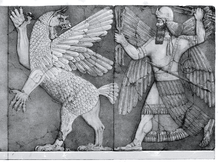Nammu
| Part of a series on |
| Ancient Mesopotamian religion |
|---|
 |
|
Demigods and heroes |
| Related topics |
In Sumerian mythology, Nammu (also Namma, spelled ideographically 𒀭𒇉 dNAMMA = dENGUR) was a primeval goddess, corresponding to Tiamat in Babylonian mythology.
Nammu was the Goddess sea (Engur) that gave birth to An (heaven) and Ki (earth) and the first gods, representing the Apsu, the fresh water ocean that the Sumerians believed lay beneath the earth, the source of life-giving water and fertility in a country with almost no rainfall.
Nammu is not well attested in Sumerian mythology. She may have been of greater importance prehistorically, before Enki took over most of her functions. An indication of her continued relevance may be found in the theophoric name of Ur-Nammu, the founder of the Third Dynasty of Ur. According to the Neo-Sumerian mythological text Enki and Ninmah, Enki is the son of An and Nammu. Nammu is the goddess who "has given birth to the great gods". It is she who has the idea of creating mankind, and she goes to wake up Enki, who is asleep in the Apsu, so that he may set the process going.[1]
The Atrahasis-Epos has it that Enlil requested from Nammu the creation of humans. And Nammu told him that with the help of Enki (her son) she can create humans in the image of gods.
Reay Tannahill in Sex in History (1980) singled out Nammu as the "only female prime mover" in the cosmogonic myths of antiquity. [2]
References
External links
- Ancient Mesopotamian Gods and Goddesses: Namma (goddess)
- Electronic Text Corpus of Sumerian Literature